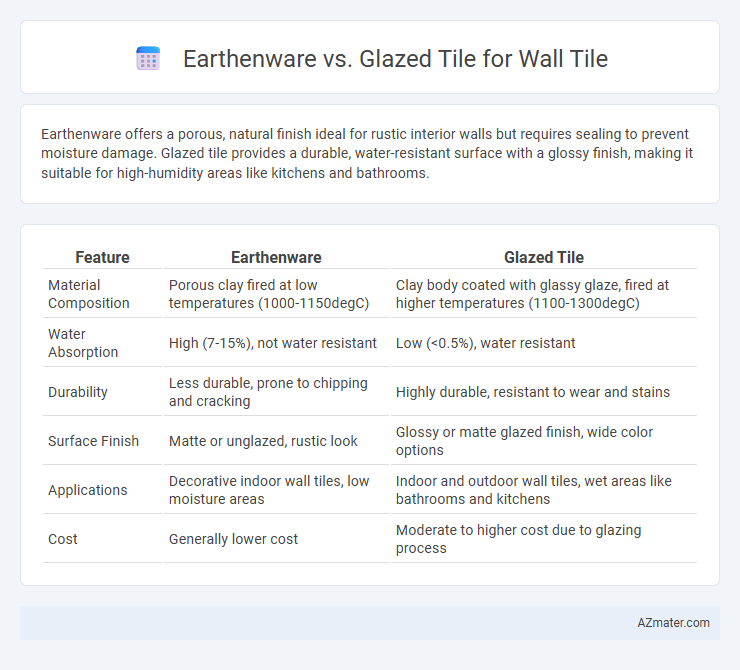Earthenware offers a porous, natural finish ideal for rustic interior walls but requires sealing to prevent moisture damage. Glazed tile provides a durable, water-resistant surface with a glossy finish, making it suitable for high-humidity areas like kitchens and bathrooms.
Table of Comparison
| Feature | Earthenware | Glazed Tile |
|---|---|---|
| Material Composition | Porous clay fired at low temperatures (1000-1150degC) | Clay body coated with glassy glaze, fired at higher temperatures (1100-1300degC) |
| Water Absorption | High (7-15%), not water resistant | Low (<0.5%), water resistant |
| Durability | Less durable, prone to chipping and cracking | Highly durable, resistant to wear and stains |
| Surface Finish | Matte or unglazed, rustic look | Glossy or matte glazed finish, wide color options |
| Applications | Decorative indoor wall tiles, low moisture areas | Indoor and outdoor wall tiles, wet areas like bathrooms and kitchens |
| Cost | Generally lower cost | Moderate to higher cost due to glazing process |
Introduction to Wall Tile Options
Earthenware and glazed tile are popular wall tile options that offer distinct aesthetic and functional benefits. Earthenware is porous, often unglazed, providing a rustic, natural look ideal for low-moisture areas, while glazed tile features a glass-like coating for enhanced durability, water resistance, and a wide variety of colors and patterns suitable for kitchens and bathrooms. Understanding these characteristics helps in selecting the right tile based on moisture exposure, maintenance needs, and design preferences.
What is Earthenware Tile?
Earthenware tile is a porous ceramic material made from natural clay fired at lower temperatures than stoneware or porcelain, resulting in a softer and more absorbent surface. These tiles are typically thicker, heavier, and less durable, making them ideal for low-traffic interior walls rather than floors. Compared to glazed tiles, earthenware can be left unglazed or coated with a matte or glossy glaze, providing a rustic, handcrafted aesthetic prized in traditional and vintage-inspired interior designs.
What is Glazed Tile?
Glazed tile is a type of ceramic tile coated with a glass-like substance that creates a smooth, glossy surface, making it highly resistant to moisture, stains, and scratches. Its waterproof properties and vibrant color options make it ideal for wall applications, especially in kitchens and bathrooms. Compared to earthenware, glazed tiles offer enhanced durability and easier maintenance, ensuring long-lasting aesthetic appeal.
Durability Comparison: Earthenware vs Glazed Tile
Earthenware wall tiles are more porous and less durable compared to glazed tiles, making them susceptible to chipping and water damage over time. Glazed tiles feature a protective glass-like coating that enhances resistance to scratches, stains, and moisture, ideal for high-traffic or wet areas. The durability advantage of glazed tiles ensures longer-lasting wall applications, particularly in kitchens and bathrooms where durability and ease of maintenance are critical.
Water Resistance and Maintenance
Earthenware wall tiles have lower water resistance due to their porous nature, making them more susceptible to moisture absorption and staining, which requires regular sealing and careful maintenance. Glazed tiles feature a non-porous, glass-like surface that provides superior water resistance and easy cleaning, reducing the risk of mold and mildew in wet areas. For areas prone to high moisture, glazed tile is the preferred choice for durability and low maintenance.
Aesthetic Differences and Design Choices
Earthenware wall tiles offer a rustic, natural look with matte finishes and earthy tones, ideal for creating warm, traditional, or handcrafted aesthetics in interior spaces. Glazed tiles provide a glossy, vibrant surface with a wide range of colors and patterns, enabling sleek, contemporary designs and easier maintenance. Choosing between earthenware and glazed tiles depends on the desired texture, durability, and the overall style mood you want to achieve in your wall design.
Cost and Installation Factors
Earthenware wall tiles are generally more affordable than glazed tiles, making them a cost-effective option for budget-conscious projects. The installation of earthenware tiles is simpler due to their lighter weight and softer texture, which allows for easier cutting and fitting. Glazed tiles often require specialized tools and more precise handling during installation, leading to higher labor costs and longer project timelines.
Best Applications for Earthenware Tiles
Earthenware tiles are ideal for low-traffic interior walls due to their porous nature and rustic aesthetic, making them perfect for kitchens, bathrooms, and decorative accent walls. Their natural absorbency allows for vibrant glaze finishes that enhance color depth, but they require sealing in moisture-prone areas to prevent damage. Compared to glazed tiles, earthenware offers a more traditional and warm look, best suited for spaces where durability under heavy wear is not a primary concern.
Best Uses for Glazed Tiles
Glazed tiles are ideal for wall applications in kitchens, bathrooms, and high-moisture areas due to their water-resistant and easy-to-clean surface. Their non-porous glaze protects against stains, mold, and scratches, making them perfect for maintaining hygiene and durability in frequently used spaces. Unlike earthenware, glazed tiles offer a wide variety of colors and finishes, enhancing both functionality and aesthetic appeal in interior wall designs.
Choosing the Right Tile for Your Walls
Earthenware tiles offer a porous, rustic texture ideal for low-moisture areas, providing a warm, natural aesthetic, while glazed tiles feature a protective, waterproof surface suitable for kitchens and bathrooms due to their durability and ease of cleaning. Selecting the right wall tile depends on the room's moisture level and desired appearance, with earthenware favored for decorative, dry spaces and glazed tiles preferred for high-traffic, wet environments. Consider factors like maintenance, slip resistance, and long-term wear to ensure the tile choice enhances both function and style in your interior design.

Infographic: Earthenware vs Glazed Tile for Wall Tile
 azmater.com
azmater.com